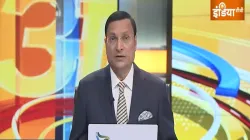OPINION | Mumbai waterlogging: Shinde can't shift his blame on others
Large parts of roads in Dadar, Sion, Hindmata, Andheri, Vakola, Matunga, Bhandup, Santa Cruz and Bandra-Kurla looked like flowing rivers. The worst-hit areas were Andheri, Milan and Malad subways.

Life in Mumbai was disrupted after the first heavy downpour of monsoon, measuring more than 300 mm, drowned the metropolis early on Monday morning. The downpour began at around 1 am and continued non-stop till 4 am, inundating roads and throwing traffic out of gear. Both Western and Central Railway services came to a virtual halt due to waterlogged tracks. Large parts of roads in Dadar, Sion, Hindmata, Andheri, Vakola, Matunga, Bhandup, Santa Cruz and Bandra-Kurla looked like flowing rivers. The worst-hit areas were Andheri, Milan and Malad subways. Hundreds of officegoers were stuck due to inundated roads. Schools and colleges were closed and people were advised to remain indoors. Several flights to and from Mumbai had to be either cancelled or rescheduled. At least 50 flights had to be cancelled due to heavy rains and low visibility and the planes had to be diverted to Ahmedabad, Hyderabad and Indore.
Several MLAs and ministers could not reach the assembly and secretariat. Weather office has declared red alert for the next four days in Mumbai. Soon after the water level receded, there were huge crowds of commuters inside local trains and at bus stops, trying to reach their destinations desperately. Waterlogging in Mumbai due to heavy rains has been a regular feature almost every year with low-lying areas facing the brunt. Mithi river, Oshiwara, Dahisar and Poisar are water bodies which overflow whenever there is heavy downpour. If there is high tide, the situation turns worse and water enters most of the parts of the city. The third biggest problem is drainage. Lack of proper cleaning of drains causes water to flow back on the roads and into localities. Maharashtra chief minister Eknath Shinde visited the BMC disaster control room to take stock of the situation with the help of nearly 7,000 cctv cameras installed inside. The opposition, led by Congress and Shiv Sena (UBT), took jibes at Shinde saying that he was more interested in photo-ops instead of taking preventive measures to avoid waterlogging. It is a fact that every year the state government and BMC claim that they have made full preparations for the onset of monsoon, and every year the people of the metropolis face the same waterlogging problems. You will be surprised to know that the annual budget of Brihanmumbai Municipal Corporation (BMC) is more than the budtets of several state governments.
This year, BMC budget is to the tune of Rs 60,000 crore, whereas Himachal Pradesh's annual budget is only Rs 53,000 crore. BMC claims it spends 10 per cent of its budget, which is Rs 6000 crore, on cleaning up drains, repairing potholes and other civic necessities. Out of this, Rs 545 crore was earmarked for repairing potholes on roads, but the visuals after Monday rains are there for all to see. Every year political parties level charges and counter-charges against each other. It's true Chief Minister Shinde cannot evade his accountability by saying that his government is only two years old. Shinde has been questioning why earlier governments did not improve the conditions of the city. One should ask Shinde, it was the Shiv Sena which controlled the BMC for the last 30 years, and he was then an important leader of the united Shiv Sena. He had been an MLA and a minister, and he was holding the portfolio that looked after Mumbai's civic issues. The question arises, why Shinde did not took measures at that time. The root of the problem lies in the system that is faltering. No single individual can be held accountable. All stakeholders of the city should join hands and work towards mitigating the miseries of the people. Only then can Mumbaikars heave a sigh of relief when there is a heavy downpour.
Aaj Ki Baat: Monday to Friday, 9:00 pm
India's Number One and most followed Super Prime Time News Show 'Aaj Ki Baat- Rajat Sharma Ke Saath' was launched just before the 2014 General Elections. Since its inception, the show has redefined India's super-prime time and is numerically far ahead of its contemporaries.

